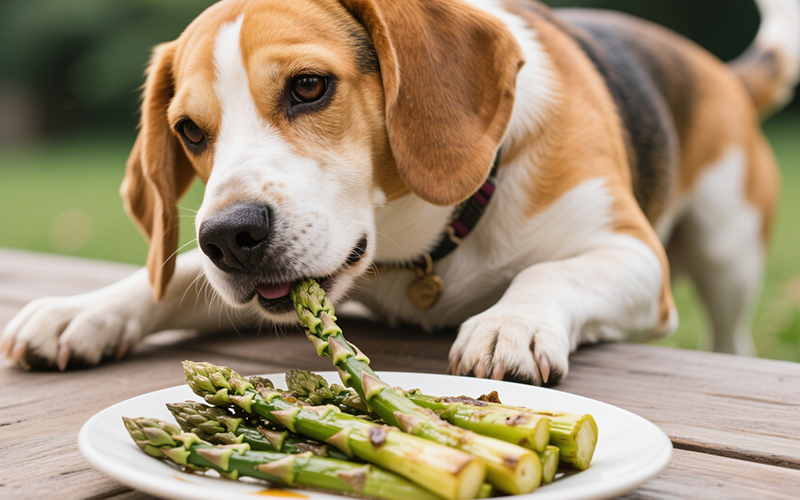Can Dogs Eat Cooked Asparagus? The Vet-Approved Guide You Need
- 11 Apr 2025 16:28
As loving pet parents, we often wonder if sharing our healthy snacks with our furry companions is a good idea. Asparagus, a nutrient-packed spring vegetable, frequently pops up on this list. You've cooked up some delicious asparagus for dinner, and those puppy eyes are pleading for a bite. But the crucial question remains: can dogs eat cooked asparagus safely? The short answer is yes, dogs *can* eat cooked asparagus in moderation, but there are important considerations and potential risks to understand before adding it to their diet. This comprehensive guide will delve into the benefits, risks, and safe preparation methods, ensuring you make informed decisions for your dog's health.
Understanding the nuances of feeding human food to dogs is paramount. While some vegetables offer significant health advantages, others can cause digestive upset or even toxicity. Let's break down everything you need to know about dogs and cooked asparagus.

Is Asparagus Generally Safe for Dogs?
Plain asparagus itself, the spear we commonly eat, is not considered toxic to dogs. This is a crucial distinction because the asparagus fern, the decorative plant counterpart, *is* toxic due to a compound called sapogenin, which can cause vomiting, diarrhea, and skin irritation upon contact or ingestion. Always ensure you're only considering the edible asparagus spears (Asparagus officinalis) for your canine friend.
However, "safe" doesn't mean "without potential issues." The primary concerns revolve around how asparagus is prepared and the form in which it's offered. Raw asparagus, for instance, presents different challenges compared to cooked asparagus.
Raw vs. Cooked Asparagus for Dogs
While raw asparagus isn't toxic, it's generally not recommended for dogs. Here's why:
Toughness: Raw asparagus stalks are fibrous and very tough, making them difficult for dogs to chew properly. This poses a significant choking hazard, especially for smaller breeds or dogs that tend to gulp their food.
Digestibility: The tough texture also makes raw asparagus hard to digest, potentially leading to gastrointestinal upset, including gas, bloating, vomiting, or diarrhea.
Cooked asparagus, on the other hand, is much softer and easier for dogs to chew and digest. Cooking breaks down the tough fibers, making the nutrients more accessible and reducing the risk of choking and digestive issues. This is why the focus is typically on whether dogs eat asparagus cooked, as it's the generally safer option.
Nutritional Benefits of Cooked Asparagus for Dogs
When prepared correctly (plainly cooked and chopped), asparagus can offer several health benefits for dogs, thanks to its rich nutritional profile. It's packed with essential vitamins, minerals, and antioxidants:
Vitamins: Asparagus is a good source of Vitamin K (essential for blood clotting and bone health), Vitamin A (supports vision, skin, coat, and immune function), Vitamin C (an antioxidant that boosts the immune system), Vitamin E (protects cells from damage), and various B vitamins (including folate/B9, crucial for cell growth and metabolism).
Minerals: It contains potassium (important for nerve and muscle function), phosphorus (works with calcium for bones and teeth), and smaller amounts of calcium, iron, and zinc.
Fiber: Asparagus is high in dietary fiber, which aids in digestion and promotes regular bowel movements. However, too much fiber can also cause digestive upset, highlighting the need for moderation.
Antioxidants: Compounds like glutathione and flavonoids found in asparagus help fight oxidative stress and inflammation, potentially reducing the risk of chronic diseases.
Feeding small amounts of properly prepared cooked asparagus for dogs can be a healthy way to supplement their diet with these beneficial nutrients, treating it as a low-calorie, nutritious snack rather than a meal staple.
Potential Risks and Concerns When Feeding Cooked Asparagus
Despite the benefits, feeding cooked asparagus to your dog isn't entirely risk-free. Awareness of these potential issues is crucial for ensuring your dog's safety:
1. Preparation Method Matters Immensely
How you cook asparagus is critical. While plain, steamed, or boiled asparagus is best, many human preparations involve ingredients that are harmful or even toxic to dogs:
Garlic and Onions: These common additions are toxic to dogs, potentially causing damage to red blood cells (anemia).
Oils and Butter: High-fat ingredients can lead to gastrointestinal upset (diarrhea, vomiting) and, in severe cases, pancreatitis, a painful and potentially serious inflammation of the pancreas.
Salt and Seasonings: Excessive salt is bad for dogs, potentially leading to sodium ion poisoning. Other spices can irritate a dog's stomach.
Therefore, if you're asking "can dogs eat asparagus cooked?", the answer is heavily dependent on it being cooked *plain*, without any added fats, salts, or seasonings.
2. Choking Hazard (Even When Cooked)
Although cooking softens asparagus, the stalks can still be fibrous, especially the thicker ends. If not cut into small, bite-sized pieces, even cooked asparagus can pose a choking hazard, particularly for smaller dogs or fast eaters. Always chop cooked asparagus into manageable pieces before offering it.
3. Digestive Upset
Asparagus is known to cause gas in humans, and the same can happen in dogs. Its high fiber content, while beneficial in moderation, can lead to:
Increased flatulence
Bloating
Diarrhea
Mild stomach discomfort
Introduce asparagus slowly and in tiny amounts to see how your dog tolerates it. If you notice any adverse digestive signs, discontinue feeding it.
4. Asparagus Pee
Just like in humans, asparagus contains asparagusic acid. When metabolized, this compound breaks down into sulfur-containing byproducts, which can make urine smell distinctively strong and unpleasant. While this is harmless, don't be alarmed if you notice a change in the odor of your dog's urine after they've eaten asparagus.
5. Potential for Allergic Reactions
While rare, dogs can develop allergies to almost any food, including asparagus. Signs of an allergic reaction might include itching, skin rashes, hives, swelling, or gastrointestinal distress. If you suspect an allergy, stop feeding asparagus and consult your veterinarian.
How to Safely Prepare Cooked Asparagus for Your Dog
If you've weighed the pros and cons and decided to offer your dog some cooked asparagus, follow these steps for safe preparation:
Wash Thoroughly: Rinse the asparagus spears under cool running water to remove any dirt, pesticides, or contaminants.
Trim the Ends: Cut off the tough, woody bottom ends of the stalks. These parts are very fibrous and difficult to digest, even when cooked, and pose a higher choking risk.
Chop into Small Pieces: Cut the remaining tender parts of the spears into small, bite-sized pieces (e.g., half-inch to one-inch segments, depending on your dog's size). This minimizes the choking hazard and aids digestion.
Cook Plain: The best methods are steaming or boiling. Cook the asparagus pieces until they are tender but not mushy. Do NOT add any salt, butter, oil, garlic, onions, or other seasonings. Plain is the only safe way.
Cool Completely: Allow the cooked asparagus pieces to cool down thoroughly before offering them to your dog to prevent burns to their mouth.
Serve in Moderation: Start with just one or two small pieces to see how your dog reacts.
Remember, cooked asparagus for dogs should only be considered a treat, not a regular part of their meals.
How Much Cooked Asparagus Can My Dog Eat?
Moderation is key. Treats, including healthy ones like cooked asparagus, should not make up more than 10% of your dog's total daily caloric intake. For most dogs, this means only a few small pieces of cooked asparagus offered occasionally.
Consider these factors:
Dog Size: A large breed dog might tolerate a few more pieces than a small toy breed.
Overall Diet: Ensure their primary nutrition comes from high-quality, balanced dog food.
Individual Tolerance: Observe your dog for any signs of digestive upset (gas, diarrhea). If they occur, asparagus might not be suitable for them, or the amount needs to be reduced significantly.
Health Status: Dogs with sensitive stomachs, pancreatitis history, or kidney issues might need to avoid asparagus. Always consult your vet if your dog has pre-existing health conditions.
Rule of Thumb: Start small (1-2 tiny pieces) and observe for 24-48 hours. If there are no adverse effects, you can offer it occasionally as a treat. Never feed large quantities.
Recognizing Problems: When to Call the Vet
While plain, properly prepared cooked asparagus is generally safe in small amounts, be vigilant for signs of trouble:
Choking: Gagging, pawing at the mouth, difficulty breathing, blue-tinged gums (requires immediate intervention!).
Vomiting or Severe Diarrhea: Especially if persistent or contains blood.
Lethargy or Weakness: Could indicate a more severe reaction or underlying issue.
Abdominal Pain: Whining, restlessness, reluctance to be touched, hunched posture.
Signs of Allergic Reaction: Excessive itching, hives, swelling (especially around the face).
If you observe any of these symptoms after your dog eats asparagus (or any new food), contact your veterinarian or an emergency animal hospital immediately.
Exploring Safe Alternatives: Other Veggies for Dogs
If you're looking for healthy vegetable treats for your dog, but are hesitant about asparagus or find your dog doesn't tolerate it well, consider these generally safer options (always prepared plain and chopped):
| Vegetable | Benefits & Preparation Notes |
| Carrots | Good for teeth (raw, large pieces for chewing under supervision), high in Vitamin A. Can be served raw or cooked (steamed/boiled). Low calorie. |
| Green Beans | High in fiber, vitamins, and minerals. Serve steamed, boiled, or even raw (chopped). Ensure they are plain (no salt/additives if canned). A good alternative to asparagus for dogs. |
| Pumpkin | Excellent for digestive health (both constipation and diarrhea). Use plain, canned pumpkin puree (NOT pumpkin pie filling). High in fiber and vitamins. |
| Sweet Potatoes | Rich in vitamins, minerals, and fiber. Must be cooked (steamed, boiled, baked) until soft and served plain, peeled, and chopped. Offer in moderation due to higher calories/starch. |
| Broccoli | Contains vitamins and fiber. Serve steamed or boiled, chopped small. Florets contain isothiocyanates, which can cause gastric irritation in some dogs if fed in large amounts. Moderation is crucial. |
Always introduce any new vegetable slowly and monitor for reactions.
Need Quick Pet Health Advice? Try PettureX!
Navigating the world of safe foods and pet health can be overwhelming. Sometimes you need quick answers you can trust. That's where the PettureX App comes in handy!
PettureX is an innovative application designed for modern pet parents. Key features include:
Image Recognition: Unsure of your dog's breed or curious about a plant they encountered? Use the app's image recognition feature for quick identification.
Pet Health Analysis: Snap a photo of a concerning skin condition or other visible issue, and the app's AI can provide preliminary insights into potential health problems.
24/7 AI Vet Consultation: Have questions like "can dogs eat cooked asparagus right now?" or worried about a minor symptom? Get instant advice and potential solutions from the AI-powered veterinary consultant, available anytime, anywhere.
While PettureX offers valuable support and information, remember it's designed to complement, not replace, professional veterinary care. For serious conditions or emergencies, always contact your local vet immediately.
Conclusion: The Verdict on Cooked Asparagus for Dogs
So, back to our main question: can dogs eat cooked asparagus? Yes, they can, but with several important caveats. Plain, thoroughly cooked (steamed or boiled), and finely chopped asparagus can be a safe, low-calorie, and nutritious treat for most dogs when offered in strict moderation.
Key Takeaways:
Preparation is Crucial: Only plain cooked asparagus is safe. Avoid raw asparagus and never feed asparagus cooked with oils, fats, salt, garlic, onions, or other seasonings.
Portion Control: Treat asparagus as an occasional snack, constituting less than 10% of their daily food intake. A few small pieces are usually sufficient.
Potential Risks: Be mindful of choking hazards (chop finely!), digestive upset (gas, diarrhea), and the (harmless) potential for smelly urine.
Know Your Dog: Introduce slowly and monitor for any adverse reactions. Consult your vet before introducing new foods, especially if your dog has health issues.
Asparagus Fern is Toxic: Ensure you are only dealing with the edible vegetable spears.
By following these guidelines, you can safely determine if cooked asparagus is an appropriate treat for your beloved canine companion. Always prioritize their safety and consult your veterinarian if you have any doubts or concerns about your dog's diet or health. Sharing food can be a bonding experience, but doing so responsibly ensures your furry friend stays happy and healthy for years to come.
Related

Radish Bites for Your Buddy? A Vet-Reviewed Guide on Whether Dogs Can Eat Radishes
- 22 Apr 2025
Potato Peels for Pooches? Unpeeling the Risks and Facts for Dog Owners
- 22 Apr 2025
Crunchy Curiosity: Can Dogs Safely Snack on Pork Rinds? A Deep Dive
- 21 Apr 2025
Pomegranate Seeds and Pooches: A Deep Dive into Whether Dogs Can Safely Indulge
- 21 Apr 2025
Can Dogs Eat Peaches? Vet Explains Benefits, Cyanide Risks & Safe Serving
- 16 Apr 2025
Can Dogs Eat Mulberries? Vet Explains Safety, Benefits & Potential Risks
- 16 Apr 2025
Can Dogs Eat Mozzarella? Vet Explains the Cheesy Truth (Risks & Benefits)
- 16 Apr 2025
Can Dogs Eat Mango Skin? Vet Explains Why It's a Risky Chew!
- 16 Apr 2025
Can Dogs Eat Maple Syrup? The Sugary Truth & Why Vets Advise Against It
- 16 Apr 2025
Can Dogs Eat Mac n Cheese? Vet Explains Why This Comfort Food Is Unsafe!
- 16 Apr 2025
